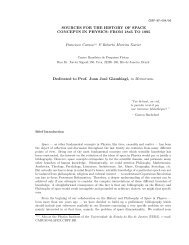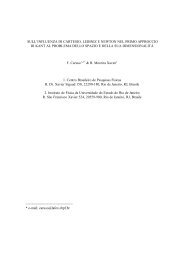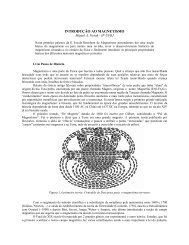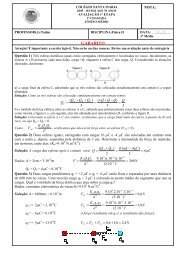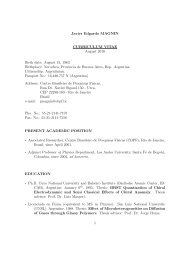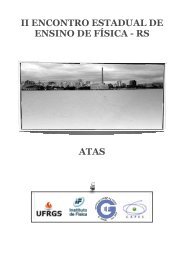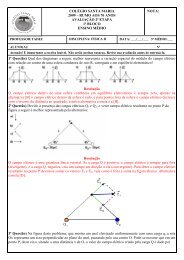Primordial non-Gaussianity in the cosmological perturbations - CBPF
Primordial non-Gaussianity in the cosmological perturbations - CBPF
Primordial non-Gaussianity in the cosmological perturbations - CBPF
You also want an ePaper? Increase the reach of your titles
YUMPU automatically turns print PDFs into web optimized ePapers that Google loves.
The energy (number) density scales like <strong>the</strong> <strong>in</strong>verse of <strong>the</strong> volume whose size is ∼ a 3 On <strong>the</strong> o<strong>the</strong>r<br />
hand, if <strong>the</strong> universe is dom<strong>in</strong>ated by, say, radiation, <strong>the</strong>n one has <strong>the</strong> equation of state P = ρ/3,<br />
<strong>the</strong>n<br />
ρr a 4 = constant (RADIATION). (53)<br />
The energy density scales <strong>the</strong> like <strong>the</strong> <strong>in</strong>verse of <strong>the</strong> volume (whose size is ∼ a 3 ) and <strong>the</strong> energy which<br />
scales like 1/a because of <strong>the</strong> red-shift: photon energies scale like <strong>the</strong> <strong>in</strong>verse of <strong>the</strong>ir wavelenghts<br />
which <strong>in</strong> turn scale like 1/a. More generally, for matter with equation of state parameter w, one<br />
f<strong>in</strong>ds<br />
ρ a 3(1+w) = constant. (54)<br />
In particular, for w = −1, ρ is constant and corresponds, as we will see more explicitly below, to a<br />
<strong>cosmological</strong> constant vacuum energy<br />
ρΛ = constant (VACUUM ENERGY). (55)<br />
The early universe was radiation dom<strong>in</strong>ated, <strong>the</strong> adolescent universe was matter dom<strong>in</strong>ated and<br />
<strong>the</strong> adult universe is dom<strong>in</strong>ated, as we shall see, by <strong>the</strong> <strong>cosmological</strong> constant. If <strong>the</strong> universe<br />
underwent <strong>in</strong>flation, <strong>the</strong>re was aga<strong>in</strong> a very early period when <strong>the</strong> stress-energy was dom<strong>in</strong>ated by<br />
vacuum energy. As we shall see next, once we know <strong>the</strong> evolution of ρ and P <strong>in</strong> terms of <strong>the</strong> scale<br />
factor a(t), it is straightforward to solve for a(t). Before go<strong>in</strong>g on, we want to emphasize <strong>the</strong> utility<br />
of describ<strong>in</strong>g <strong>the</strong> stress energy <strong>in</strong> <strong>the</strong> universe by <strong>the</strong> simple equation of state P = wρ. This is<br />
<strong>the</strong> most general form for <strong>the</strong> stress energy <strong>in</strong> a FRW space-time and <strong>the</strong> observational evidence<br />
<strong>in</strong>dicates that on large scales <strong>the</strong> RW metric is quite a good approximation to <strong>the</strong> space-time with<strong>in</strong><br />
our Hubble volume. This simple, but often very accurate, approximation will allow us to explore<br />
many early universe phenomena with a s<strong>in</strong>gle parameter.<br />
2.2 The Friedmann equations<br />
After <strong>the</strong>se prelim<strong>in</strong>aries, we are now prepared to tackle <strong>the</strong> E<strong>in</strong>ste<strong>in</strong> equations. We allow for <strong>the</strong><br />
presence of a <strong>cosmological</strong> constant and thus consider <strong>the</strong> equations<br />
It will be convenient to rewrite <strong>the</strong>se equations <strong>in</strong> <strong>the</strong> form<br />
Rµν = 8πGN<br />
Gµν + Λgµν = 8πGNTµν. (56)<br />
<br />
Tµν − 1<br />
2 gµνT λ λ<br />
20<br />
<br />
+ Λgµν. (57)




